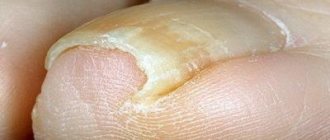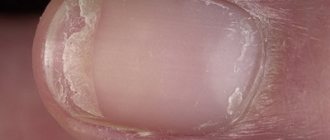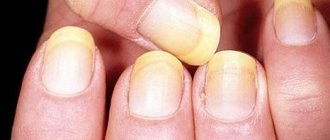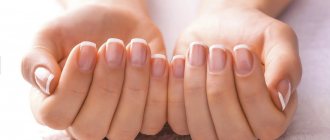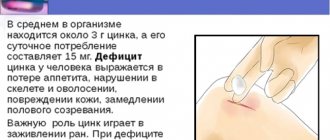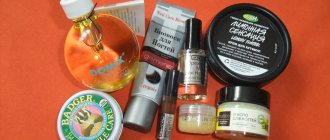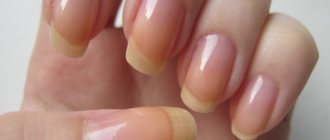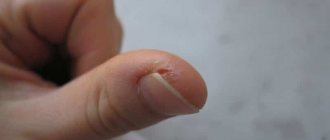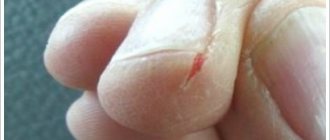What causes?
The causes of onychorrhexis are divided into internal and external. When the body weakens, chronic pathologies, infections, the nail initially grows fragile. It cracks easily, delaminates, breaks off from the free edge. Due to impaired blood flow and chronic diseases, longitudinal splitting of the nail is often found in older people. The older the person, the higher the risks. Aging of the body is the most common reason.
Internal factors include:
- diabetes, thyrotoxicosis, cause metabolic disorders;
- atherosclerosis, lead to a decrease in the lumen of blood vessels, a decrease in blood flow, and the supply of nutrients;
- eczema, psoriasis, cause inflammation, disruption of the nail structure;
- autoimmune diseases (Raynaud's syndrome, vasculitis), damage the walls of blood vessels, nutrition of the matrix, reduce the strength of the resulting plate;
- lack of vitamins and minerals in the body due to malnutrition, eating disorders (anorexia, bulimia) or gastrointestinal diseases that interfere with the absorption of nutrients and change the chemical composition of the plate;
- fungal infection, provokes an inflammatory process, destroys the healthy structure of the nail;
- tumor diseases.
External factors can cause dystrophy:
- injuries received during a manicure or pedicure;
- household damage;
- working with cleaning agents and detergents without protective gloves;
- wearing shoes that don't fit;
- features of the profession: working at a computer with nails tapping on the keyboard, or playing the piano;
- continuous wearing of gel polish or artificial coverings;
- using acetone-based nail polish removers;
- habit of biting nails;
- frequent contact with water, alcohol, solvents, chemicals that dry out and damage the plate;
- Excessive length, improper cutting of nails.
In children, onychorrhexis is caused by trauma, decreased immunity, and previous infectious diseases.
Why do cracks appear on fingernails and toenails?
Through the transparent nail plate, the pinkish soft tissues of the bed are clearly visible, and there should be no spots, stripes, grooves or dents on the nail itself. Any crack on the nail can ruin the entire impeccable manicure and give a woman’s fingers an unkempt appearance. Of course, you can correct the defect by repairing the nail plate, and traces of a deep crack can easily be hidden under layers of thick gel polish. But if a crack appeared on the nail not after a bruise or improper home care of the fingers, but as a result of diseases of the internal organs, then cosmetic masking of the defect can only aggravate the problem.
Cracks can appear both along and across the nail plate. If the splitting of the nail occurs in the transverse direction with fragmentation into leaf-shaped elements (onychoschisis), then the causes of such dystrophic changes are usually external factors. Violation of the structure of the nail plate with splitting in the longitudinal direction (onychorrhexis) from the base to the free edge may be a symptom of a chronic disease of the body. Internal or external factors can cause not only deformation of the nail plates, but also the soft tissues surrounding them. For example, very often cracks appear on the fingers near the nails. The skin on the nail phalanges is very delicate and after aggressive external exposure, the keratinized epithelium dries and cracks. Cracks near the nails appear after prolonged exposure to ultraviolet radiation, contact of fingers with household chemicals, or incorrect processing of the side rollers with a router for hardware manicure. If external factors are excluded, and the keratinized skin around the nail plates continues to crack, then be sure to consult a dermatologist for advice. — in the photo: splitting the nail plate in the longitudinal direction (onychorrhexis) — in the photo: splitting the nail plate in the transverse direction (onychoschisis) ♦ REASONS FOR CRACKS ON THE NAILS ❶ Violation of the rules for performing manicure/pedicure. Improper cuticle removal using manicure trimming tools can lead to damage to living tissue and infection of the matrix. As a result, new plates grow deformed and with transverse grooves. Filing nails with metal or very rough files leads to delamination of the plates and the appearance of cracks. It is also dangerous to sand the surface of your nails after steaming. To perform a manicure, choose glass or ceramic files; ❷ Foreign body. If nails split, a hard foreign body may become stuck between the keratin layers and the gap gradually widens; ❸ Household chemicals. Constant contact of dishwashing detergents with nail plates, the use of acetone and bleach when cleaning a room without special gloves can lead to thinning and brittle nails. The stability of the bonds between the keratin layers deteriorates and onychoschisis develops; ❹ Injuries. Bruising or pinching of the nail phalanx can cause cracks, which can gradually deepen as the plates grow; ❺ Onychophagia. The habit of biting nails is common mainly among preschool children. On the bitten free edge of the plate, vertical gaps remain, which increase in size; ❻ Infectious diseases. Infectious diseases most often affect the toenails, especially the big toe. Through open wounds on the nail folds, infection (staphylococci, streptococci) penetrates the matrix and the new nail grows deformed, with grooves and cracks. Fungal spores often land on the toes, which develop and destroy the structure of the nails. Nails become brittle and begin to crack without proper treatment; ❼ Violations of body functions. Onychorrhexis can be caused by diseases such as psoriasis, dehydration, vitamin deficiency, diabetes mellitus, hormonal imbalance, abnormalities in the liver and gastrointestinal tract. ♦ TREATMENT OF ONYCHODYSTROPHY There are many ways to eliminate damage to the nail plate caused by mechanical stress at home. But if signs of dystrophy appear on all nails, then you should definitely visit a specialist (dermatologist, podologist or mycologist). After examination and diagnosis, the doctor will prescribe a comprehensive treatment for the disease, help you adjust your daily diet, and soon only healthy nails will grow on your fingers. ▪ Vitamin and mineral supplements will help compensate for the lack of nutrients in the body (vitamins A, C, B, E, calcium, iron, phosphorus); ▪ Paraffin therapy. Fingers are dipped into a bath of heated paraffin. The procedure helps normalize the functioning of the matrix, improves the regeneration of the soft tissues of the nail bed and increases blood flow; ▪ Firming mask. Combine a tablespoon of olive oil with 1 teaspoon of lemon juice and a teaspoon of glycerin. Rub the mixture into the nail plates and periungual skin. After 20 minutes, remove the mask with a cotton pad and wash your hands in warm water; ▪ Bath with gelatin. A good product for restoring nail structure. Pour hot water (200 ml) into a tablespoon of edible gelatin, mix and after 10 minutes add a teaspoon of nourishing oil (wheat germ, rose hip, apricot, burdock, jojoba or almond). Immerse your fingers in the bath for 15 minutes. It is enough to perform the procedure 2-3 times a week; ▪ Wax ointment. We combine beeswax, almond oil, aloe juice and the yolk of a chicken egg (hard-boiled) in equal proportions. We treat each nail phalanx with a paste-like ointment and after an hour, remove the dried product with warm water. ♦ REASONS FOR CRACKS IN THE SKIN AROUND NAILS ❶ Temperature changes. Rough skin near the nails dries and cracks during sudden temperature changes due to hypothermia; ❷ Hard water. The skin on the fingers is especially vulnerable when washing dishes using abrasive detergents without rubber gloves; ❸ Internal reasons. Lack of vitamins in the body (A, E, D), gastrointestinal diseases, problems with the thyroid gland, psoriasis, severe stress. If the skin on your fingers is very rough, constantly peeling and cracking, be sure to make an appointment with a dermatologist. ► How to get rid of cracks on your fingers near the nails: • Homemade mask. Mix 1 tbsp. a spoonful of glycerin, 1 teaspoon of liquid honey and 40 ml. water. Then add flour to the mixture (the consistency of the mask should be like mayonnaise). Apply the mask to the skin of your fingers and wash off with warm water after 30 minutes. • Finger bath. Softens and moisturizes the skin, has a healing effect on dry epidermis. Recipe: pour 2 tablespoons of linden blossom (can be replaced with chamomile or sage) with two glasses of boiling water. Add 1 teaspoon of starch to the bath, mix everything thoroughly and after 5 minutes dip your fingers into the mixture. After 20 minutes, wipe your hands dry with a towel. • Medical glue BF-6. If a deep crack appears near the nail, then cover it with a few drops of BF-6 glue, which has anti-inflammatory and antibacterial properties. The hardened glue will reliably protect the wound from infection entering the soft tissue. • Antibacterial and wound-healing ointments. Ointments such as Pantoderm, Boroplus, Panthenol, Bepanten, Eplan, ichthyol will help improve the condition of the skin around the nails. Treat your fingers with chamomile or castor oil at night. It is useful to treat deep cracks with tea tree essential oil. ♦ VIDEO MATERIALS
Please leave comments on the article, share with each other the secrets of home care for problematic fingernails or toenails. To the main page
ALSO FIND OUT...
| Comments | Add new | Search |
Children's Portal: Home Page
3.26 Copyright (C) 2008 Compojoom.com / Copyright (C) 2007 Alain Georgette / Copyright (C) 2006 Frantisek Hliva. All rights reserved."
Related materials:
- A tiny newborn baby looks very fragile and mothers take their firstborn in their arms with understandable trepidation and are afraid of accidentally harming him...
“>Learning to hold a baby in your arms in different ways
- Carving is a gentle hair styling method with long-lasting results. Thanks to this procedure, even very thin and sparse hair turns into luxurious...
“>Carving for hair (results in the photo, important tips)
- The glazing procedure helps to transform hair, even with very thin and frizzy hair, into a luxurious hairstyle with silky and smooth curls...
">Remedies for silk glazing at home
- I use the salon service for Brazilian hair straightening using keratin several times a year since I learned about the benefits of this…
“>Applying keratin to strands and heat treatment with an iron
- Mesotherapy helps to significantly improve the condition of the hair and only a certified specialist should perform this popular procedure. Especially the act...
“>How to restore the volume of thinning hair and speed up hair growth
The following materials:
- Healthy nails with an impeccable manicure, neatly trimmed cuticles, elastic periungual skin without...
">Causes of hangnails and their removal from fingers near nails
- Inflammation of the soft tissues on the toe can cause very unpleasant pain and problems while walking. Most often, an abscess appears on a pain...
“>Abscess on the toe near the nail. How to treat felon at home
- Abscesses near the nails quite often appear on children’s fingers (especially in babies who constantly bite their nails), but many women...
“>Abscess on the finger near the nail. How to treat paronychia at home
- Purulent inflammation under the nail can cause very unpleasant pain and interfere with an active lifestyle. If pus has formed under the nail...
“>Pus under the nail of the big toe or hand. Treatment methods
- Healthy nail plates are characterized by a dense structure, good elasticity and a smooth surface without deformed areas. Some pathologists...
“>What to do if the nails on your fingers are bent
Previous materials:
- According to statistics, fingers and toes are among the most vulnerable parts of the body, and a bruised nail can be caused by a strong blow to a limb on a ledge, hitting...
“>What to do if a bruised toenail turns blue
- Onychodystrophy is a pathological change in the appearance of the nail plate and surrounding soft tissues. Changing the appearance of the nail phalanx...
">Causes of onychodystrophy in women and nail treatment
- Onycholysis is the detachment of the nail from the nail bed, caused by the gradual destruction of the connective tissue fibers of the reticular layer of the dermis, fixing the nails...
“>Treatment of onycholysis on the arms and legs. Detachment of nails (photo)
- Children with inflamed skin on their fingers are among the most frequent visits to the pediatrician. From an early age, a child shows curiosity and incredible...
“>The felon is on a child’s finger or toe. Home treatment
- Panaritium refers to infectious diseases that cause purulent inflammation on the finger after the pathogen penetrates the soft tissues of the…
">Removal of an abscess and home treatment of felon on the toe
- Panaritium refers to inflammatory diseases of finger tissue. The subcutaneous tissue of the finger on the hand is the most vulnerable tissue for g...
“>How to treat felon after opening a purulent abscess on the finger
- Paronychia (paronychia) is an inflammation of the periungual fold, which most often occurs on the hands, but sometimes develops on the feet (especially on the b...
“>How to treat paronychia of a finger on the hand after opening an abscess
- Nail psoriasis in the medical literature is called psoriatic onychodystrophy and refers to chronic autoimmune diseases that require…
“>How to treat psoriasis of toenails, photo of affected plates
- Psoriasis is a chronic skin disease of a non-infectious nature that develops when the normal functioning of the immune system is disrupted...
“>How and with what to treat psoriasis of fingernails at home
- A nail growing into the soft tissue of the finger causes discomfort and can cause debilitating pain. And if onychocryptosis develops extremely rarely on the hands,...
“>Safe removal of ingrown toenails with laser or radio waves
- With active load on the foot, the sharp corners of the hard nail plate can dig into the deep layers of soft tissue on the side rollers, which inflame...
“>The nail grows into the finger. Modern methods of treatment without surgery
- An ingrown toenail causes serious discomfort and pain while moving. Most often, the big toe “suffers” from ingrown toenails...
“>Orthonyxia. Plates and staples for correcting ingrown toenails
- The side rolls on the fingers are formed from a fairly elastic and elastic fabric, which is characterized by increased resistance to injury. However, the rest…
“>Ingrown toenail. Causes and treatment of onychocryptosis in a child
- Yellowed nails look unsightly and give our fingers an untidy appearance. If yellowness “decorates” the nail plates on the toes, then it’s worn...
“>Why do yellow nails grow on fingers or toes?
- The appearance of healthy nail plates is characterized by a smooth surface, natural shine and good transparency on the nail bed, pale pink…
“>Deformation of nails and thickening of the plate on the big toe
Next page>>
What are the symptoms?
The main sign is the presence of longitudinal cracks on the plate, running from the free edge to the center or base of the nail. They look like grooves or furrows. Depending on the cause, there may be one or several cracks, only on one finger or more. Onychorrhexis affects the fingernails and toenails, but is more common on the hands. On the feet, only the big toe is predominantly affected.
What onychorrhexis looks like is shown in the photo of the nail below:
In addition to longitudinal cracks, thinning of the plate, a change in color to yellowish or grayish, and an uneven laminated free edge are also possible. Due to increased fragility, longitudinal splitting is often combined with transverse splitting, which is called onychoschisis.
Vertical grooves on the nails, reminiscent of onychorrhexis, are characteristic of trachyonychia. And their treatment principles are similar. This is a type of onychodystrophy in which the nails become dull, rough, and covered with grooves and scales.
Preventive measures for cracking of the nail plate
Prevention is better than cure. Prevention of cracked nails is no exception.
Take care of your feet
- You cannot save on cosmetic hygiene products - try to buy high-quality soaps, gels, creams. Otherwise, it is quite possible that problems with the skin and toenails will occur.
- Prevention of fungal diseases requires compliance with the rules of personal hygiene, the use of special sprays that refresh the skin of the feet and protect against fungal infection. You will have to stop wearing other people's shoes and socks, and walk barefoot on the ground or sand with caution.
- It is recommended to choose comfortable, high-quality shoes that do not compress the foot, which will prevent injury to its parts.
- Compliance with the diet is mandatory. Food is recommended to be varied, rich in vitamins and microelements. You should avoid fatty, spicy foods, avoiding digestive problems that affect the condition of the nail plates. It is necessary to regularly consume vitamin complexes.
- Pedicures are prescribed to be done exclusively with sterile, high-quality instruments; use should be accompanied by minimal trauma to the nail plates. If a pedicure is done in a cosmetology office or salon, you need to choose experienced, skilled professionals. Saving will lead to disastrous consequences.
Diagnostics
If you find a plate splitting, contact a podiatrist or dermatologist to prevent the condition from getting worse. If left untreated, the crack will grow and reach the free edge. It will divide the nail into two halves and cause detachment from the bed. In addition, violation of the integrity of the plate opens access to pathogenic pathogens and often leads to bacterial or fungal infectious complications.
The specialist will examine the structure of the plate, assess the severity of the damage, suggest how to treat onychorrhexis of the fingernails or toenails, and how to improve their appearance.
To find out the cause, he will ask the patient about chronic diseases and prescribe additional examinations:
- examination of a nail scraping for fungus;
- general blood test, sugar test;
- consultation with an endocrinologist, gastroenterologist, vascular surgeon;
- microscopic examination;
- examination with a dermatoscope at 10x magnification.
How to treat?
To treat onychorrhexis, an integrated approach is used, aimed at eliminating the cause, normalizing metabolic processes, and strengthening the structure of the nails. If these conditions are met, treatment gives a good result. True, it takes up to six months, since the nail plate grows slowly, on average by 1 mm per week. The matrix where nails are formed is hidden under the skin of the lower roller, at a distance of 4 mm from the cuticle. It will take 4 weeks just to improve his condition, and to change the plate on his fingers it will take 4 to 6 months.
Treatment is selected depending on the severity of the injuries and the person’s health status. When identifying concomitant pathologies that cause longitudinal clefting, attention is paid to their treatment.
To strengthen nails the following is prescribed:
- massage;
- vitamins, amino acids, minerals;
- medicinal baths;
- drugs to strengthen the walls of blood vessels and improve blood circulation in the extremities;
- physiotherapy (paraffin therapy, ozokerite, mud masks).
Traditional methods and remedies for the treatment of onychorrhexis of nails include masks or baths with natural oils, oil solutions of vitamins, gelatin, as well as moisturizing and nourishing creams. They help strengthen nails and accelerate regeneration processes. But it is better to discuss the safety of their use with your doctor.
In case of deep, long cracks, the plate is reinforced with artificial materials to stabilize it.
Traditional methods
Herbal masks
Herbal mask for nails
To prepare such a mask, any of the components must be crushed using a blender or grater. After mixing all the ingredients, apply the mask to the nails and distal phalanges of the fingers, leave for up to 15 minutes. The procedure should be carried out after a short massage or warming bath.
The following masks are useful:
- from cabbage and potatoes in equal proportions with the addition of cream;
- from carrots, with the addition of lemon juice and olive oil;
- from cottage cheese and sour cream;
- from bananas.
Wax film mask
You need to melt the wax in a water bath and cool it to normal temperature. Next, dip your fingertips into the viscous wax and remove, waiting until the wax hardens. You need to perform this procedure before going to bed, and in the morning, wash off any remaining wax on your fingers with water. Do this procedure 2-3 times every week.
Baths
Activating blood circulation will help improve tissue trophism. And this can be achieved if you regularly take baths with sea salt and essential oils.
To prepare such a bath, you need to take 1 liter of warm water, a couple of drops of any essential oil and 2 tbsp. l. sea salt. The essential oil is first dissolved in a few drops of vegetable oil. You need to keep your hands in the bath for 20 minutes, while performing a light nail massage. This procedure should be done 3 times a week.
Rubbing in medicated oils
Before going to bed, rub warm oil into each nail and soft tissue nearby. Lemon, sea buckthorn, avocado, olive, castor, and jojoba oils have a beneficial effect on the condition of the skin and nail plates.
Mask of iodine, clay and olive oil
You need to mix a little blue clay, warm olive oil and a few drops of iodine. After applying the mask to your nails, you need to wait 20 minutes. The procedure is carried out every day for a week.
Edible gelatin
You need to take edible gelatin jelly internally. It should be strong, and this jelly should be taken three times a day, 1 tbsp. l. for 3-4 months. The condition of your nails will improve significantly.
Care and prevention
When treating onychorrhexis, as well as for its prevention in the future, it is important to properly care for the nails, skin of the hands and feet.
What rules must be followed?
- Wash dishes and use any cleaning agents or detergents only with gloves.
- For manicure, choose high-quality varnishes with a harmless composition; do not use removers containing acetone to remove nail polish.
- Avoid frequent contact with water.
- When treating onychorrhexis, it is not recommended to do a manicure or apply any coatings to the nails other than those prescribed by the doctor. In the future, take breaks from wearing gel polish and artificial nails.
- Take care of your drinking regime and a nutritious diet, including fruits, vegetables, and low-fat protein foods.
- Do not grow your nails too long; periodically get medical manicures and pedicures at podiatry centers.
- Massage your hands and feet daily, moisturize the skin on your arms and legs with nourishing creams.
As a rule, onychorrhexis does not cause pain or inflammation, but you still need to go to a podiatrist with this problem. The specialist will prescribe the correct treatment, which will speed up the recovery of the nail and prevent the development of complications. He will also tell you about the rules of care at home so that splitting or splitting of nails no longer bothers you.
podology onychorrhexis
